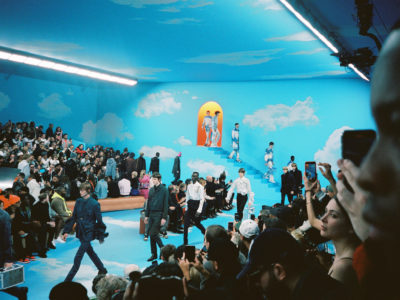The Art of the Rebrand: How Coach Became Cool Again
The Art of the Rebrand: How Coach Became Cool Again
BY: MICHAEL JOERRES
Generally speaking, “cool” is a subjective term—unless we’re talking about fashion. In the fashion world, “cool” is determined by a reached consensus and, after that, the world tends to follow suit. Since the inception of the Coach brand, historically known for its leather accessories, the company has gone in and out of fashion. In recent years, a few well-thought-out plays has led Coach to land favorably in the eyes of those that matter and the consumers that listen to them. What goes into a successful rebrand? Take notes.
New Blood
In 2013, Victor Luis took over as chief executive at an ailing American fashion house. Millennial consumers had long fallen out of love with the logo-mania of the early 2000s that characterized Coach’s previous success. Just one year after Luis took the helm, Stuart Vevers was appointed Creative Director; together, they would transform the brand. Vevers, who had previously held design posts everywhere from Louis Vuitton to Givenchy, was quick to reorient the trajectory of the house. Vevers complemented the brand’s famous accessories by focusing on a ready-to-wear line that he named Coach 1941, a nod to the year of the company’s founding. Vevers’ outerwear became even more covetable than the accessories for which he just recently won Accessories Designer of the Year at the CFDA Awards.
A New Look
Last year marked Coach’s 75th anniversary and the brand took the opportunity to pivot even further to solidify the brand’s new identity. All eyes were on a massive new flagship store, concepted on New York’s 5th avenue. Fashion’s favorite art director, Fabien Baron, laid out a beautiful art book, Coach: A Story of New York Cool that squashed any notion that the brand was irrelevant. Merchandisers moved to control Coach’s image in department stores, straying away from those retailers that cut prices on their iconic bags, elevating the brand within fashion’s hierarchy. So began Coach’s quest to dethrone fellow New York-based houses like Alexander Wang and Proenza Schouler as the go-to name for the downtown set.
Strategic Collabs
Before Vevers, it was difficult to imagine the names “Opening Ceremony” and “Coach” in the same sentence. Coach 1941 made a play for the new “It Bag” with its collaboration with Opening Ceremony last year. Partnering with Hypebeast to present features like an interview with rapper Goldlink activated the streetwear crowd. Most recently, Coach collaborated with Rodarte, the well-respected, LA-based label lauded for its innovation. By aligning with the right brands and platforms, Coach shifted the public’s perception, effectively piggybacking off the cool factor of exterior entities.
Fresh Faces
By way of campaign faces and front row attendees, Coach has gotten their product in the hands of the most influential tastemakers. In so doing, Coach has turned from a leather accessories brand to a full-fledged lifestyle brand that everyone wants in on. Effortlessly cool American Honey star, Sasha Lane, starred in the campaign for the Rodarte collab and none other than the most followed person on Instagram, Selena Gomez, was dressed by Vevers for this years Met Gala. Another digital campaign starring “It girl” Sami Miro and party appearances by Hari Nef and Chloe Wise cemented the vision of the new Coach girl.
Next Step: Fashion Domination?
In 2015, Coach acquired footwear giant Stuart Weitzman. Just last month, Coach made headlines when they acquired fellow American brand Kate Spade. Many have speculated on the plans for the house, comparing its path to that of European fashion superpower, LVMH. Fashion is famously fickle, but things are certainly looking up for Coach. We’ll just have to wait and see.





